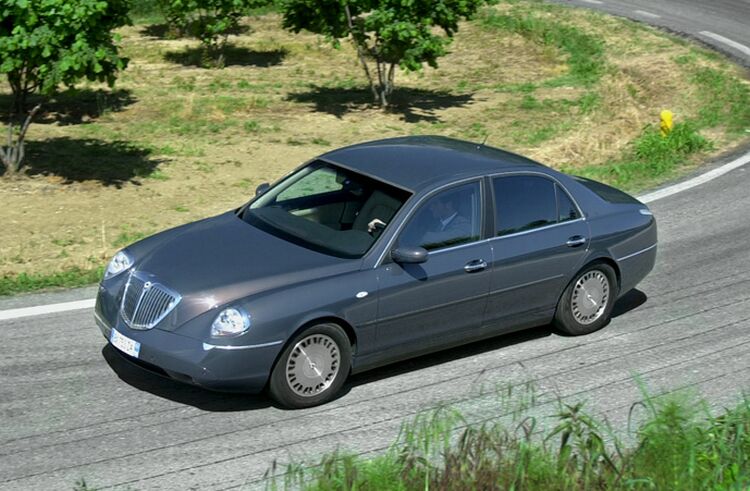
new models: Lancia Thesis 2.4 JTD 20v & 3.2 V6 24v
 |
| 3.2 V6 24v
The Lancia Thesis can now boast a brilliant 3.2 V6 24v engine. It is derived from the 3.0 V6 24v unit that equips the current top-of-the-range versions, and is ideally suited to the Lancia Thesis, producing a large luxury saloon on which roominess, comfort and performance are perfectly balanced. It is a spectacular, but above all 'round' engine - as you would expect from 6 cylinders - that stands out for its power delivery and elasticity, the latter enhanced by the converter of the automatic 5-speed transmission. It delivers an amazing 230 bhp (169 kW) at 6200 rpm, with a peak torque of 289 Nm (29.4 kgm) at 4800 rpm. Sufficient to achieve superb performance, with a torque curve that reaches very high values even at low engine speeds. But what counts most is the
delicate work done by the engineers to obtain from this engine the type
of performance we expect of a Lancia. It was refined in numerous little
ways, to obtain an extremely gradual, progressive power delivery, without
jerks when accelerating or on the release. And the result is incredibly
fluid driving.
As a whole, the Lancia Thesis 3.2 V6 is extremely enjoyable to drive. It has a top speed of 240 km/h, takes 8.8 seconds to accelerate from 0 to 100 km/h. In the urban cycle it consumes 22.7 l/100 km, 10.3 l/100 km out of town and 14.9 l/100 km on the combined cycle. The Lancia flagship equipped with this engine is the right car for the motorist who wants superlative performance without any effort. People who want to be second to none, even on the road. People who can fall in love with a beautiful, luxurious car for the unmistakable timbre of its engine. the structure It is a 6-cylinder unit in a 60° V shape, with an aluminium crankcase and cylinder head. The combustion chambers are of the 'roofed' type with a central sparkplug, and the valves are positioned at an angle of just 37°. The engineers have modified the crankshaft and pistons to increase the capacity to 3,179 cc, extending the stroke to 78 mm, an alteration that says plenty about the type of performance they were looking for. To boost the power delivery, it would actually have been sufficient to modify the timing gear, fuel supply and electronics. Increasing the capacity by extending the stroke, on the other hand, is a change that aims not only at achieving absolute performance and high power and torque levels, but also a regular, smooth delivery even at slow speeds. Which is what you want from a car capable of outstanding performance, but also suitable for use on everyday roads. The increase in capacity was obviously accompanied by a number of other measures. The intake and exhaust manifolds were 'tuned' with new valve gear timing. The injection system is also new. It adopts a Multipoint system with sequential injection, Bosch Motronic ME 7 electronic management and a 'returnless' system with selective knock control. The accelerator is of the 'drive by wire' type, with no mechanical connection between the accelerator pedal and the throttle valve. The latter is driven electronically by the engine control unit. It is a solution that guarantees known advantages in terms of reducing consumption and emissions, as well as making the car more enjoyable to drive. For example, cold starts: the warm-up phase is shortened because the catalytic converter is activated more rapidly, but at no detriment to torque or to driveability when setting off. The driver has more control over acceleration, because the control unit receives the data related to his requests 'before' it gives an order to the throttle valve. And he can enjoy the advantages of electronic speed adjustment provided by Cruise Control. To bring the engine oil to the right temperature more rapidly after a cold start, the 3.2 V6 24v has a water-oil instead of air-oil heat exchanger. The many advantages of this engine include the fact that it requires little maintenance. Apart from an oil change, the first programmed maintenance is set for 100,000 km. This is made possible by a number of technical features such as spark plugs with double platinum electrodes, hydraulic tappets and automatic tensioners on the timing belt and the poly-V belt for the auxiliary equipment. The 3.2 V6 24v is a spectacular engine but it is also a clean one. It incorporates two three-way catalytic pre-converters in the stainless steel exhaust manifolds and a double catalytic converter under the floorpan, complete with four heated lambda probes. The fuel system is of the returnless type, i.e. the petrol does not return to the tank, and a pressure adjustment valve is incorporated in the fuel pump. The result is to reduce vapour emissions. Other significant technical features are: the oil-jet piston crown lubrication system which guarantees highly efficient cooling, static ignition with one coil per cylinder and dual knock control, a sensor for each bank of cylinders right in the cylinder case, and the efficient oil pump driven by the crankshaft. |
 |
| <<< |